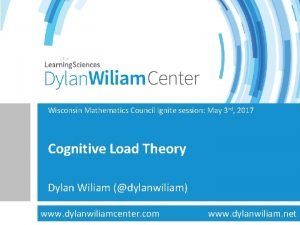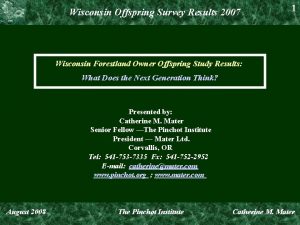Wisconsin Mathematics Council Ignite session May 3 rd




















- Slides: 20

Wisconsin Mathematics Council Ignite session: May 3 rd, 2017 Cognitive Load Theory Dylan Wiliam (@dylanwiliam) www. dylanwiliamcenter. com www. dylanwiliam. net

Kinds of knowledge: an evolutionary approach 2 Biologically primary knowledge • • Recognizing faces Recognizing speech General problem solving Learnable Not teachable Geary (2007, 2008) Biologically secondary knowledge • • Reading Writing Mathematics Learnable Teachable

Countdown game Target number: 127 3 25 9 1 4

A model of human memory 4 Environment Short-term memory Long-term memory Limited Limitless

5 • The purpose of math instruction is to build domainspecific mathematical knowledge—i. e. , long-term memory

Memory in chess 6 • Studies of memory in chess – Djakow, Petrovskij, and Rudik (1927) – Adriaan De Groot (1946) – Chase and Simon (1973)

Memory in chess (1) Mid-game 7 Player level Novice Club player Expert Random Player level Novice Club player Expert Number of pieces correctly placed 5 9 16 Number of pieces correctly placed 2 3 3

Memory in chess (2) End game 8 Player level Novice Club player Expert Number of pieces correctly placed 4 7 8 Attempts to simulate the performance of the expert chess player with computers suggest that the expert can recognize at least 10, 000, but less than 100, 000, different arrangements of chess pieces or “chunks, ” with a most likely value around 13, 500 (Simon & Gilmartin, 1973)

What is learning? 9 • Learning is “a change in long-term memory” (Kirschner, Sweller, & Clark, 2016 p. 77) • “The aim of all instruction is to alter long-term memory. If nothing has changed in long-term memory, nothing has been learned. ” (ibid p. 77) • “Novices need to use thinking skills. Experts use knowledge” (Sweller et al. , 2011 p. 21)

John Sweller 10

A mathematical problem 11 • Transform a given number to a target number using just two mathematical operations: – subtract 29 – multiply by 3 • For example – Starting number: 27 – Target number: 1027 • Solution: – x 3, — 29, x 3, — 29

The origins of cognitive load theory 12 • All the problems could be solved only in one way, which involved alternating the two available operations • Students solved the problems • But they did notice the fact that all the problems had similar solution strategies • For novices, solving problems is not the best way to get better at solving problems

Cognitive load theory 13 • Cognitive load – Intrinsic • “imposed by the basic structure of information being taught” – Extraneous • “imposed by the manner in which the information is presented or the activities in which learners must engage” • Levels of cognitive load are determined by element interactivity

Element interactivity 14 “Interacting elements are defined as elements that must be processed simultaneously in working memory because they are logically related” (Sweller, Ayres, & Kalyuga, 2011 p. 58) Low Scalene Isosceles Equilateral Medium High

Instructional design 15 • Good instruction minimizes both extraneous and intrinsic cognitive load – Extraneous cognitive load is reduced through good instructional design – Intrinsic cognitive load is reduced through good instructional sequencing

The goal-free effect 16 • “When novices solve a conventional problem, they will frequently work backwards from the goal to the givens using a means–ends strategy. ” • “In contrast, experts, using schemas held in longterm memory, know the solution and are more likely to work forward from the givens to the goal. ” • “Working memory may be overwhelmed by a means–ends strategy, reducing or even preventing learning”

Worked-example/problem completion effects 17 • “Studying worked examples provides one of the best, possibly the best, means of learning how to solve problems in a novel domain. ” (p. 107) • Strategies – Present worked example and ask students to solve a similar problem – Increase engagement by using completion problems – Guidance fading: forwards is better than backwards

Split-attention effect 18 In the figure shown, find a value for ∠ DBE Solution: ∠ ABC ∠ DBE A = 180° – ∠ BAC – ∠ BCA = 180° – 45° – 55° = 80° = ∠ ABC (vertically opposite) = 80° B D Sweller, Merrienboer and Paas (1998) 45° E 55° C

Integrated example with no split attention 19 A 45° 1 B D 2 E 80° 180° – 55° – 45° = 80° 55° C

Other important aspects 20 • • • Redundancy Modality effects Transient information effects Expertise reversal effect Collective working memory effects
 Wisconsin mathematics council
Wisconsin mathematics council Wisconsin council of teachers of english
Wisconsin council of teachers of english Repadmin showutdvec
Repadmin showutdvec Mitel ignite
Mitel ignite Ignite your business
Ignite your business Dr clive friedman
Dr clive friedman Firework figurative language
Firework figurative language Hci patterns
Hci patterns Plymouth amerika
Plymouth amerika Wisconsin in scotland
Wisconsin in scotland Wufar codes
Wufar codes Wisconsin health corps
Wisconsin health corps Tackling tire
Tackling tire Wisconsin cacfp
Wisconsin cacfp Wisconsin incident tracking system
Wisconsin incident tracking system Wisconsin dpi ptp
Wisconsin dpi ptp Witig
Witig Where is the midwest
Where is the midwest Wi dpi science standards
Wi dpi science standards Mtm wisconsin trip log
Mtm wisconsin trip log Wmels standards
Wmels standards




































